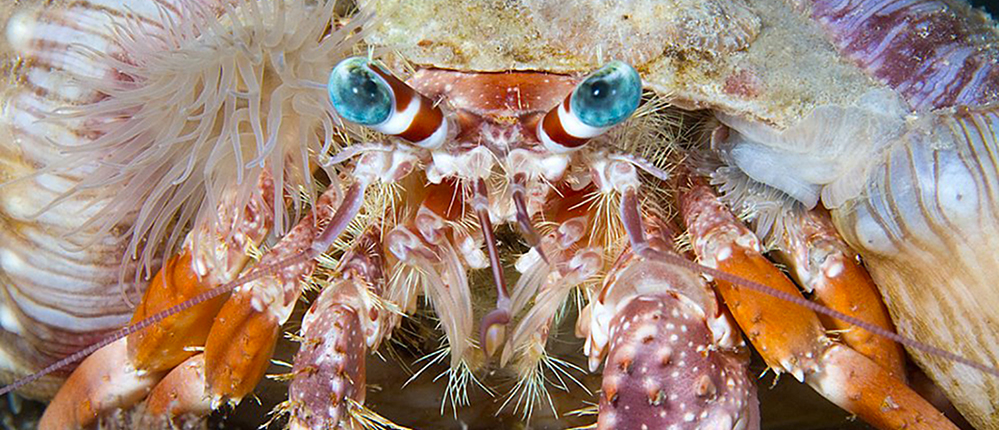Eyes On You
Diving is a visual sport, and at Wakatobi, there’s a whole lot to see. But did you ever wonder what these same reefs might look like from the fish’s point of view? Turns out that marine animals see the world in a different way—sometimes very different. Here are a few explanations of how the world might look through the eyes of some of the weird and wonderful creatures inhabiting Wakatobi’s waters.
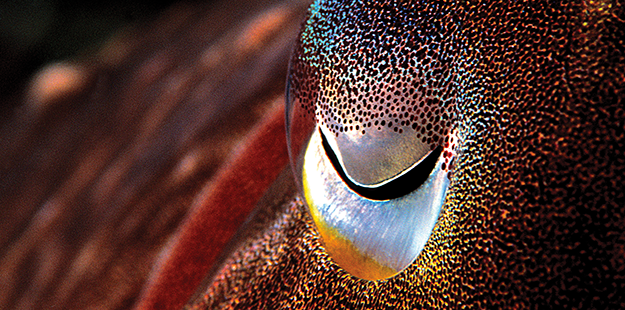
The eyes are of the octopus are very similar to mammalian eyes, although their slit-like pupils are horizontal rather than round (like ours) or vertical (like a cat’s). Photo by Wayne MacWilliams
Shifting focus
Rather than change shape to focus as is the case with most eyes, the lenses of an octopus’ eyes move in and out like a camera lens. These animals tend to be nearsighted, but they have no blind spot in their eyes, and seldom miss anything happening nearby. Another unique characteristic of octopus vision is the ability to keep the pupils of the eye oriented to the horizontal, regardless of body position. This can be a handy adaption for a creature that is always morphing its shape.
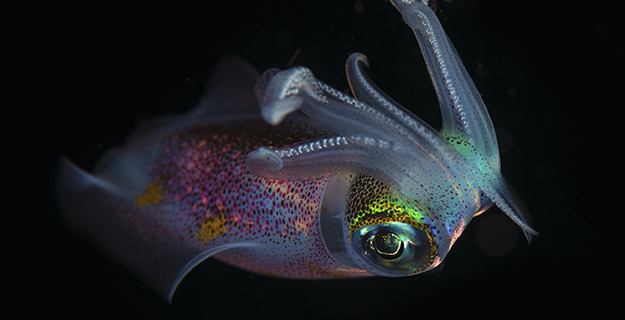
Having no color sensitive cones in their eyes, the squid sees the world in fine shades of gray. Photo by Nigel Wade
1000 shades of gray
In proportion to their bodies, squid have the largest eyes of any animal that swims into the sunlit regions of the ocean. To take advantage of these large light-gathering surfaces, squid eyes have very high numbers of photoreceptors. This allows them to see movement and fine detail in all light conditions, including the faintest of filtered starlight, but there is a trade off. By packing the eye cavity with this type of photoreceptor, there is no room for color sensitive cones, so the squid sees the world in fine shades of gray.
A wandering eye
One might say flounders are definitely “on top of it” when it comes to vision. When they first hatch, flounders have one eye on either side of their head, same as other fish. Then, as they move through the juvenile stage, and start spending most of their time lying flat on one side on the sea floor, one eye actually migrates around the body to the flounder’s top side, giving them twice the optical information when they are lying flat on the bottom. The lenses of a flounder’s eyes can move through a wide range of motion, allowing the fish to scan in all directions for food and threats. Their eyes are also adapted to gauge subtle nuances in the color and texture of their surroundings, which allows them to transform their skin tones and patterns to match the terrain.
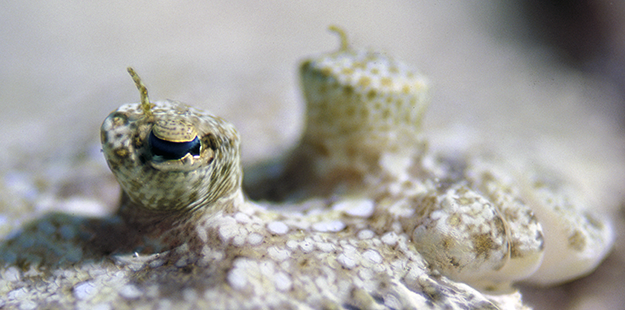
Flounders have two times the optical range when lying flat on the ocean floor and can scan in all directions for food and predators. Photo by Paul Sutherland
Night sight
The cardinalfish is a creature of the night, spending its days in dark crevices, then coming out after sunset to hunt in the gloom. To make the most of low light conditions, these fish have enlarged eyes with rounded pupils and additional rod receptors, all of which help gather more light. And much like a reflecting telescope used to concentrate the faint light of distant stars, the eyes of the cardinalfish contains a special pigment coating on the cells behind the retina that reflect and concentrate available light onto the photoreceptors. It is this reflective coating that causes the eyes of the cardinalfish to shine red when illuminated by a diver’s light or the flash of a camera strobe.
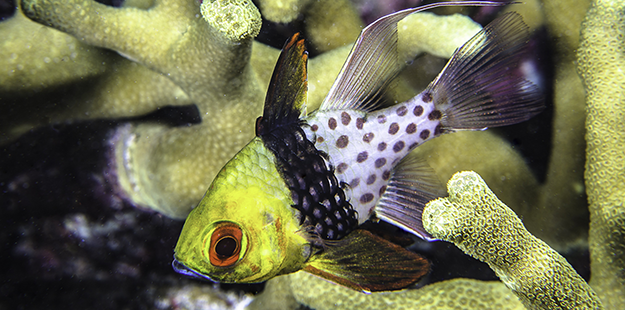
A reflective coating of pigment cells behind the retina causes the eyes of the cardinalfish to shine red when illuminated by a diver’s torch. This image of a Pajama cardinalfish was taken during a night dive at Dunia Baru. Photo by Wayne MacWilliams
Puppy dog eyes
One of the more distinctive characteristics of the pufferfish is the relatively large size of the eyes, which give the fish a seemingly expressive countenance and what some would call puppy-dog eyes. But more importantly, the outsized orbs provides sharper vision than most other fish possess—an important survival strategy that allows the puffer to identify potential threats from farther away.
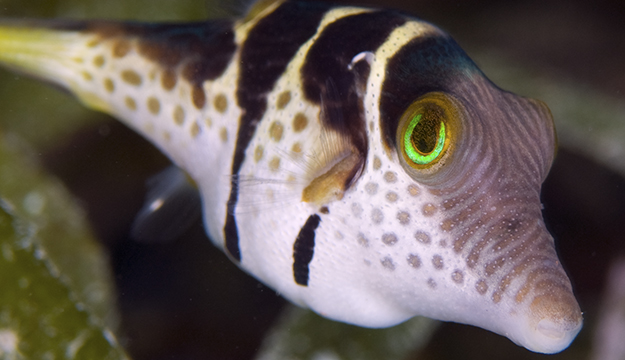
Some puffers have eyes with green iridescent layers, which reflect bright sunlight from above but still allow ambient light from surrounding environment objects to filter in. Photo by Rob Darmanin
Another ocular advantage puffer’s posses is the ability to move each eye independent of the other, allowing them to scan for threats across a wide range of vision. Both puffer eyes can also be directed forward to provide superior depth perception. Some puffers have eyes with green iridescent layers, positioned to reflect bright sunlight from above while still allowing ambient light from the surround environment objects to filter in. It’s the aquatic equivalent of mirrored sunglasses.
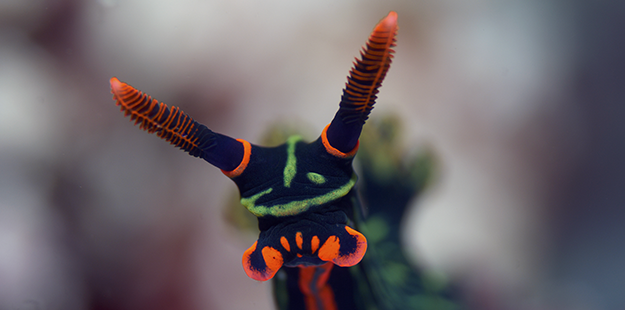
You might think the two extensions on this Nembrotha kubaryana nudibranch are its eyes staring down, but they’re actually part of it’s mouth. In reality the animal probably couldn’t distinguish the camera from the underwater surroundings until the strobe fired. Photo by Richard Smith
Only light or dark
Unless you know what you are looking for, you’re not likely to locate a nudibranch’s eyes—and in turn they can’t locate much of anything using those eyes. What passes for eyes in the shell-less mollusks provides only the most rudimentary characteristics of vision. Near the head of the animal you will find a small spot about a quarter of a millimeter in diameter that is embedded into the animal’s skin.
Nudibranchs have a very limited picture of the world as they are only able to distinguish between general states of light and darkness.
This eyespot consists of a very simple lens and a minimal number of photoreceptors. As a result of their somewhat inadequate system for vision, nudibranchs have a very limited picture of the world, as they are only able to distinguish between general states of light and darkness, and possibly detect shadows passing overhead.


